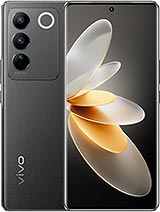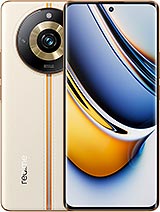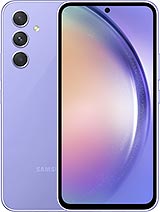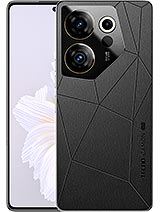Oppo Reno10 Pro review

6.7-inch 120Hz, HDR10+ AMOLED
The display is definitely the highlight of the Reno10 Pro. The phone is rocking a big 6.7-inch curved AMOLED panel. It has a resolution of 1080 x 2412 pixels, which means a pretty standard 20:9 aspect ratio and a pixel density of around 394 ppi. That's perfectly sharp in person.

Oppo claims that the Reno10 Pro should be able to do around 500 nits of typical brightness, 800 nits of maximum on the entire display and 950 nits of peak brightness. In our standardized testing, we measured 504 nits of maximum brightness and 793 nits maximum, so given the differences in testing methodology, the advertised numbers do check out. The phone even offers a special HDR brightness boost toggle for an improved HDR experience.
Thanks to its AMOLED tech and perfect deep blacks, the panel on the Reno10 Pro effectively has infinite contrast. It also gets very dim at a minimum brightness setting and only puts out 2.1 nits.
The Reno10 Pro has quite a few color modes. Vivid color mode is the default. It aims for the DCI-P3 color space and covers it rather well, but it is not terribly accurate. It tends to be a bit cold overall. Then there is the Natural mode. As the name implies, it aims for the sRGB color space and nails it with perfect coverage and accuracy. Cinematic mode is next and does an even better job than Vivid, covering the DCI-P3 color space with nearly perfect color accuracy. Finally, there is Brilliant mode, which is a lot like Vivid in its color reproduction. We aren't exactly sure why Oppo decided to include it as well.
The Reno10 Pro has a 10-bit panel. That translates to less color banding thanks to the ability to reproduce a whopping 1 billion plus colors. The display is also HDR10+ certified. On a software level, the phone can decode HDR10, HDR10+ and HLG, but not Dolby Vision.



HDR support • Netflix playback capabilities • DRM
We are also happy to report that it is certified for the highest possible Widevine L1 DRM, which allows streaming services like Netflix to offer up FullHD streams to saturate the display resolution.
Oppo has its own optimization engine baked into the Reno10 Pro. It is called the 01 Ultra Vision Engine and consists of two independent optimization systems. One is the Video Color Enhancer, which claims to intelligently identify common scenes in video and enhance their color and clarity. Then, there is Bright HDR video mode, which increases the screen's maximum brightness when playing HDR videos. Naturally, this will reduce the battery life and produce more heat.
Interestingly enough, the Image Sharpener option, as seen on the Oppo Find X6 Pro, is nowhere to be found here.
High refresh rate handling
The Reno10 Pro has a total of three refresh rate modes. There is Standard, which just acts like a 60Hz lock. Then there are the High and Auto select modes. Both tend to switch between 120Hz and 60Hz, depending on the circumstance. Technically, the phone does also support 90Hz as reported by software, but we never actually saw it trigger in practice.

Both the 120Hz mode and Auto select appear to have the same general behavior. It mostly boils down to triggering 120Hz while the display is being interacted with and then, after a few seconds of inactivity, switching down to 60Hz.
This is fairly basic logic, but it generally works rather well to save unnecessary power draw. The phone does not appear to monitor motion on the display, but some interfaces and apps still run at a fixed 120Hz refresh rate without ever going down to 60Hz. That isn't the norm, but it still indicates that the refresh rate is sometimes and somehow dependent on the content that is being displayed.
Regarding gaming, the Auto select and 120Hz modes seem to behave identically as well. That is to say that as long as you are interacting with the display, the refresh rate is 120Hz, which quickly drops to 60Hz after a few seconds of inactivity.
This is hardly the best behavior we have seen, but overall we can't complain too much about the high refresh rate handling on the Reno10 Pro.
Battery life
The Reno10 Pro has a sizeable, but not huge, 4,600 mAh battery on board. It makes sense, seeing that the phone is quite thin at 7.9mm and pretty light at 185 grams. Oppo still managed to cram in quite a bit of battery capacity.
The overall battery endurance is what you'd expect from a phone in this price range. The gaming score is a bit off, but the rest of the screen-on tests seem to be in line with the competition. The talk time endurance is considerably higher, though, pushing up the Active Use Score.
Expand to reveal our legacy battery test (Endurance rating). How we test now.
Battery life
The Reno10 Pro has a sizeable, but not huge, 4,600 mAh battery on board. It makes sense, seeing that the phone is quite thin at 7.9mm and pretty light at 185 grams. Oppo still managed to cram in quite a bit of battery capacity.
The phone runs on a 6nm Snapdragon 778G chipset - a well-known and popular chip that has proven decently efficient in the past. The Reno10 Pro does alright in the battery department with a total endurance rating of 104 hours. That's about what we would expect from this battery and chipset combo, and it's decent but nothing to phone home about.
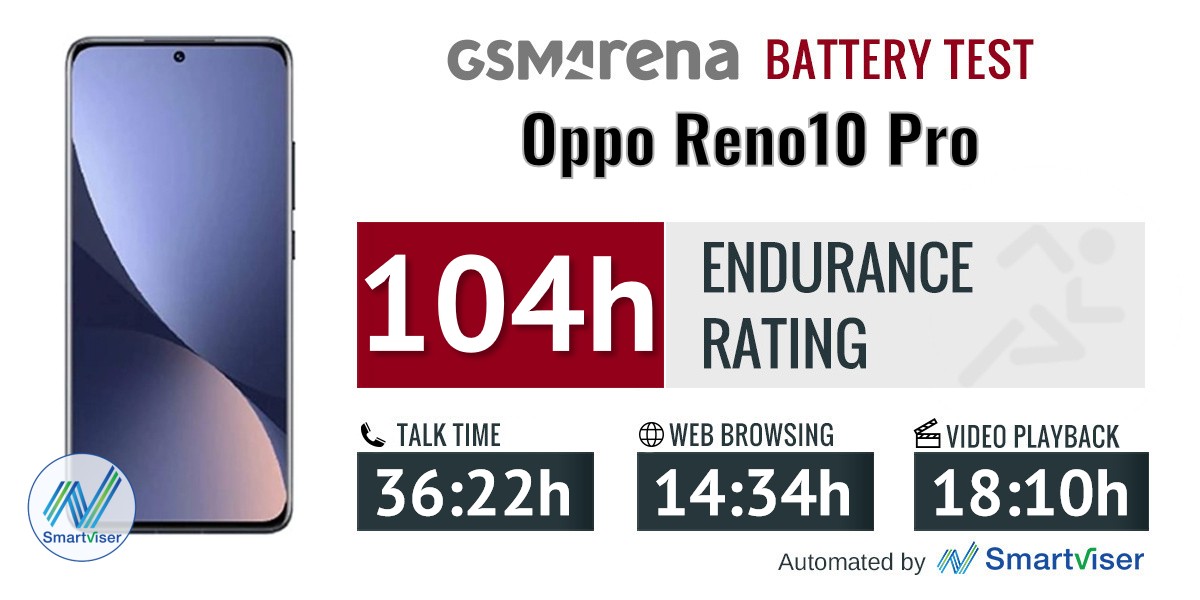
As a reminder, the web browsing portion of our testing was conducted at the phone's top 120Hz refresh rate mode, while the video test part was done at 60Hz.
Our battery tests were automated thanks to SmartViser, using its viSerDevice app. The endurance rating denotes how long the battery charge will last you if you use the device for an hour of telephony, web browsing, and video playback daily. More details can be found here.
Video test carried out in 60Hz refresh rate mode. Web browsing test done at the display's highest refresh rate whenever possible. Refer to the respective reviews for specifics. To adjust the endurance rating formula to match your own usage patterns check out our all-time battery test results chart where you can also find all phones we've tested.
Charging speed
The Reno10 Pro supports up to 80W fast charging. Its primary charging standard is SUPERVOOC, though the phone also officially supports VOOC 2.0, PD3.0 (9V/2A) and QC3.0 (9V/2A), obviously at a slower charging rate.

The Reno10 Pro ships with an 80W SUPERVOOC charger in the box. The charger is clearly proprietary and supports 5V@2A (10W) standard USB power as well as 5V-11V@7.3A (max 80W) for SUPERVOOC. You should probably hold on to the charger if you want to use the fastest possible charging rates on the Reno10 Pro. The included USB Type-A to Type-C cable seems pretty standard, though, so it should be easy enough to replace if misplaced or broken.
The Reno10 Pro charges up quite rapidly with its included 80W SUPERVOOC adapter. We got it from dead all the way up to 58% in 15 minutes, and a charge to 100% took exactly 30 minutes. The battery indicator might be a bit deceitful, though, since the phone continued to trickle charge for about four and a half minutes after that, which means that a full charge technically took us 34.5 minutes.
Speaker
The Reno10 Pro only has a single bottom-firing speaker at its disposal. That is quite disappointing, given that many of its price-comparative competitors from other brands do offer very decent stereo speaker setups. Furthermore, the lone speaker on the Reno10 Pro is not particularly impressive in any way. It doesn't get too loud, only managing an AVERAGE score in our testing, and its output is nothing to phone home about. It gets the job done, but nothing really beyond that.

The Reno10 Pro does have a basic audio enhancement suit on board.
It is called Real Sound Technology and comes with a total of three audio presets, plus a Smart mode that promises to recognize scenarios and adapt the sound accordingly automatically.
Use the Playback controls to listen to the phone sample recordings (best use headphones). We measure the average loudness of the speakers in LUFS. A lower absolute value means a louder sound. A look at the frequency response chart will tell you how far off the ideal "0db" flat line is the reproduction of the bass, treble, and mid frequencies. You can add more phones to compare how they differ. The scores and ratings are not comparable with our older loudspeaker test. Learn more about how we test here.
Reader comments
- Pascal hebarti
- 05 Feb 2025
- NwF
Phone is very good bu in my country Tanzania city mbeya town i ndont see this phone Oppo reno 10 pro+ 5G
- ppp
- 22 Oct 2023
- dZP
a52s doesn't have a telephoto and is not a flagship
- Anonymous
- 04 Oct 2023
- CbG
it's dolby atmos support








